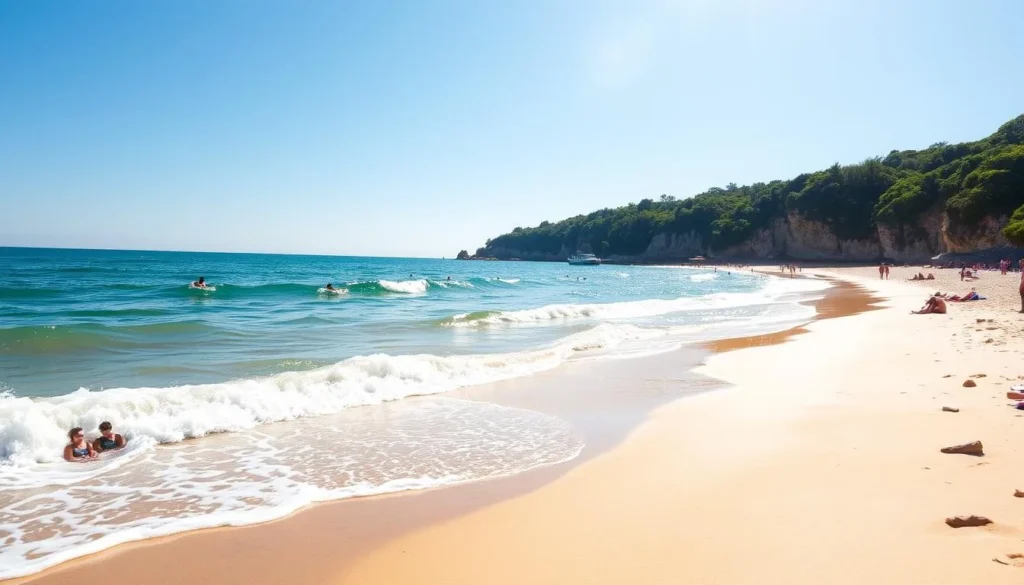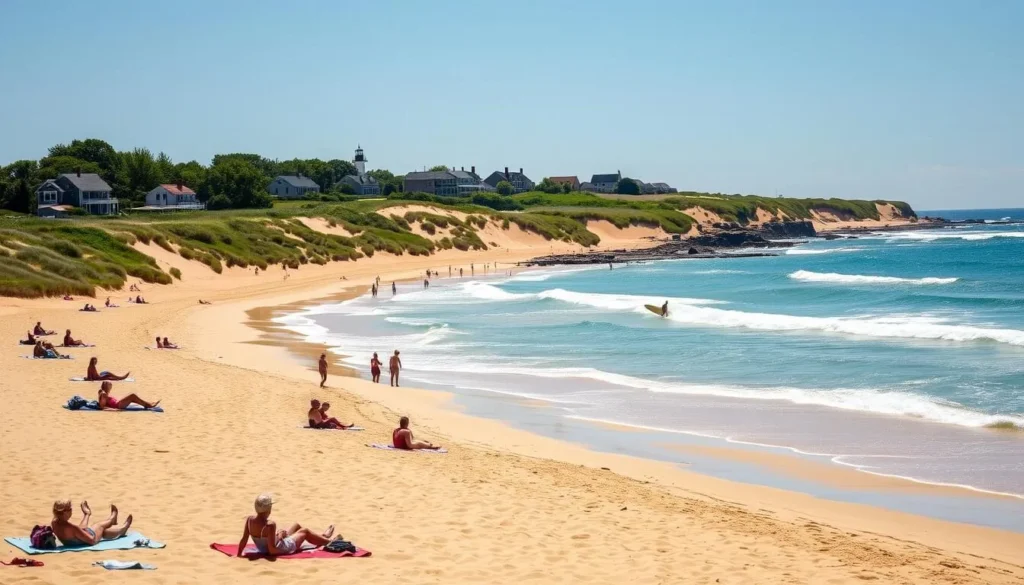✓ Accommodations✓ Flights✓ Rental Cars
Did you know that Martha’s Vineyard attracts over 800,000 visitors each year? The island’s unique climate creates distinct seasonal experiences, making it essential to understand weather patterns before planning your trip.
The island’s weather varies significantly across the four seasons, from warm summer days to peaceful winter retreats. Understanding these temperature patterns and seasonal events will help you make informed decisions about when to book your trip.
By identifying the ideal season for your preferences, you can maximize your enjoyment and create unforgettable memories on this beloved Massachusetts destination.
Understanding Martha’s Vineyard’s Unique Climate
Surrounded by the Atlantic Ocean, Martha’s Vineyard experiences a moderated climate. The island’s weather is shaped by its maritime surroundings, creating a distinct environment that differs from mainland New England locations.
Geographic Influences on Island Weather
The geography of Martha’s Vineyard plays a significant role in its climate. The island’s location off the coast of Massachusetts means that it is highly influenced by the surrounding Atlantic Ocean. This maritime influence moderates the island’s temperatures throughout the year, creating more stable conditions compared to inland areas.
How Ocean Currents Affect Temperatures Year-Round
Ocean currents around Martha’s Vineyard significantly impact the island’s weather. The Gulf Stream brings warmth during colder months, while the Labrador Current can cool the island in the summer. These currents help regulate the island’s climate, preventing extreme temperature fluctuations. As a result, the island enjoys milder winters and cooler summers, making it an attractive destination year-round. The water temperatures around the island also lag behind air temperatures, extending summer-like conditions into early fall.

The unique combination of geographic and oceanic influences on Martha’s Vineyard creates a pleasant season for visitors. Understanding these factors can help you plan your trip to the island, ensuring that you make the most of your time on this beautiful island in Massachusetts.
Spring Awakening: March to May Weather Patterns
As spring arrives, Martha’s Vineyard transforms into a vibrant destination. The island’s weather during this time is characterized by a gradual warming trend, making it an ideal time to visit before the peak summer season.
March: Winter’s Last Stand
In March, Martha’s Vineyard is still experiencing the remnants of winter. Temperatures are cool, and the island can see some late-season snowfall. However, the average temperatures begin to rise, signaling the start of the transition towards warmer weather.
April: The Island’s Gradual Warming
April marks the beginning of the island’s gradual warming. The weather becomes milder, with average highs increasing. It’s a great time for outdoor activities like hiking and biking, as the island starts to bloom.
May: The Sweet Spot Before Summer
May is considered one of the best times to visit Martha’s Vineyard. With average highs reaching a comfortable 65°F and lows around 50°F, it’s perfect for outdoor activities. The island hosts several events, including Edgartown’s Pink & Green Weekend around Mother’s Day and the Vineyard Artisans Festival during Memorial Day weekend. 
- The weather in May is ideal, with comfortable temperatures and fewer crowds.
- Most seasonal businesses reopen in May, offering a full island experience.
- Special events like Edgartown’s Pink & Green Weekend and the Vineyard Artisans Festival make May a great time to visit.
Visiting Martha’s Vineyard in the spring, especially in May, offers a great balance of pleasant weather, open businesses, and manageable visitor numbers, making it an ideal time for a trip.
Summer Paradise: June to August Weather Overview
Martha’s Vineyard in the summer is a haven for those seeking warm weather, beautiful beaches, and a lively atmosphere. You can expect a vibrant island experience during these months.
June: Early Summer Charm
June marks the beginning of summer on Martha’s Vineyard, with mild temperatures and a refreshing atmosphere. It’s an ideal time to enjoy the island’s beach activities before the peak season crowds arrive. The weather is usually pleasant, making it perfect for outdoor events.
July: Peak Season Heat and Humidity
July is the peak of summer on Martha’s Vineyard, characterized by warm temperatures and higher humidity. It’s the busiest month, with a variety of events and activities. You can enjoy water sports and other outdoor pursuits during this time.
August: Perfect Beach Weather
 beach weather on Martha’s Vineyard, with average highs of 80°F and lows of 64°F. The water temperatures are also at their warmest, around 68°F, ideal for swimming and other water activities. The island hosts several notable events in August, including the Martha’s Vineyard Agricultural Fair and Grand Illumination Night in Oak Bluffs.
beach weather on Martha’s Vineyard, with average highs of 80°F and lows of 64°F. The water temperatures are also at their warmest, around 68°F, ideal for swimming and other water activities. The island hosts several notable events in August, including the Martha’s Vineyard Agricultural Fair and Grand Illumination Night in Oak Bluffs.
- The Martha’s Vineyard Agricultural Fair is a four-day celebration showcasing the island’s agricultural heritage.
- Grand Illumination Night in Oak Bluffs is a unique event featuring colorful lanterns at the historic gingerbread cottages.
August combines the best elements of summer on Martha’s Vineyard, with warm weather, special events, and full seasonal operations. However, it’s also the peak tourist season, with larger crowds and premium prices.
Fall Splendor: September to November Conditions
As summer fades, Martha’s Vineyard transforms into a haven of fall splendor, offering a unique experience for visitors. The island’s fall season is characterized by a gradual cooling of temperatures and a change in foliage, making it an attractive time to visit for those who enjoy milder weather and fewer crowds.
September: Extended Summer Vibes
In September, Martha’s Vineyard still enjoys warm weather, with average highs in the mid-70s to low 80s Fahrenheit. This extended summer vibe makes it an ideal time for outdoor activities like beach trips and hiking. The island is less crowded than in the peak summer months, providing a more relaxed atmosphere for visitors.
October: Fall Foliage and Cooling Temperatures
October brings a noticeable cooling of temperatures, with average highs ranging from the mid-60s to low 70s Fahrenheit. The fall foliage is in full swing, with the island’s trees displaying vibrant colors. This makes October a great time for nature walks, scenic drives, and enjoying the island’s natural beauty.
November: Transition to Winter
By November, the weather on Martha’s Vineyard has cooled significantly, with average highs around 54°F and lows approaching 39°F. This marks the transition to winter, with the island taking on a quieter, more serene atmosphere. Visitors can enjoy the island’s peaceful ambiance, cozy inns, and holiday preparations, making it a unique and charming time to visit.

Winter on the Vineyard: December to February Experience
The winter months bring a distinct character to Martha’s Vineyard, making it an attractive destination for those seeking a cold-weather getaway. You can experience the island’s serene beauty, enjoy winter activities, and take advantage of lower accommodation rates.
December: Holiday Season Weather
December marks the beginning of winter on Martha’s Vineyard, with average highs around 45°F and lows around 30°F. The island is decorated for the holiday season, creating a festive atmosphere. You can enjoy holiday events, shopping, and dining at local restaurants.
January: The Heart of Winter
January is the coldest month on the island, with average highs around 39°F and lows around 25°F. It’s a great time to enjoy winter activities like ice skating, sledding, or simply taking a brisk walk along the beach. You can also cozy up in a warm hotel room or cottage.
February: Winter’s Final Chapter
February is still quite chilly, with average highs around 39°F and lows around 25°F. However, it’s a great time to plan a romantic getaway and celebrate Valentine’s Day on the island. You can book a cozy hotel room, support locals by shopping for gifts, and indulge in a delicious meal at one of the many island restaurants. For running enthusiasts, the Martha’s Vineyard 20 Mile Race is a great opportunity to test your endurance.
| Month | Average High Temperature | Average Low Temperature |
|---|---|---|
| December | 45°F | 30°F |
| January | 39°F | 25°F |
| February | 39°F | 25°F |

Martha’s Vineyard, Massachusetts: Best Months for a Weather-Savvy Trip
To enjoy Martha’s Vineyard to the fullest, it’s crucial to time your visit with the best weather conditions. The island offers a unique experience throughout the year, but certain periods stand out for their favorable climate.
May-June: Perfect Spring Weather
The late spring and early summer months bring a serene beauty to Martha’s Vineyard. May and June are characterized by mild temperatures, ranging from 60°F to 75°F, making them ideal for outdoor activities like hiking, biking, and sailing. The island is less crowded than the peak summer months, allowing for a more relaxed experience. You can enjoy the island’s picturesque landscapes, visit historic sites, and indulge in local cuisine without the summer rush.

September-October: Ideal Fall Conditions
As summer fades, September and October bring a new kind of charm to Martha’s Vineyard. The temperatures gradually cool, offering pleasant days around 65°F to 74°F, perfect for enjoying the fall foliage. The island transforms into a colorful landscape, with the foliage creating a stunning backdrop against the ocean waters. These months also offer the advantage of fewer crowds and lower accommodation rates, making it an ideal time for those seeking a more laid-back experience. Visitors can enjoy special events like the Martha’s Vineyard Striped Bass and Bluefish Derby and the Food and Wine Festival, showcasing the island’s local bounty.
| Month | Average Temperature | Activities |
|---|---|---|
| May | 65°F | Hiking, Biking, Sailing |
| June | 70°F | Outdoor Events, Beach Activities |
| September | 74°F | Fall Foliage, Food and Wine Festival |
| October | 65°F | Striped Bass and Bluefish Derby, Hiking |
Beach Season: When to Hit the Shore
The beach season on Martha’s Vineyard is a highlight for many visitors, but when is the best time to hit the shore? Understanding the island’s beach weather and water temperatures can make your trip more enjoyable.
Water Temperature Patterns
The ocean temperatures around Martha’s Vineyard vary significantly throughout the year. During the summer months, the water temperature gradually warms up. July and August are the warmest months, with temperatures ranging between 66°F and 68°F, making these ideal for swimming and other water activities.
Best Swimming Months
The best swimming months on Martha’s Vineyard are undoubtedly July and August. During this period, not only are the water temperatures at their warmest, but the air temperatures are consistently in the high 70s to low 80s, creating perfect conditions for a day at the beach. Here are some key points to consider:
- Late July through mid-August offers the most reliable beach weather, with clear, sunny days ideal for swimming and sunbathing.
- Different beaches on the island offer varying swimming experiences; for example, South Beach and Katama tend to have warmer water temperatures compared to the north shore beaches like Owen Park Beach.
- For families with children, August is particularly comfortable for swimming due to the warmer water temperatures, making longer beach days more enjoyable.

Wind Patterns and Ferry Considerations
When planning your trip to Martha’s Vineyard, it’s essential to consider the island’s wind conditions. Wind can significantly impact ferry travel, potentially causing delays or cancellations.
Windiest Months to Avoid
The windiest months on Martha’s Vineyard are typically from October to April. During this period, winds can exceed 25-30 mph, which is the threshold for ferry cancellations. You should be prepared for potential schedule changes.
Planning Ferry Travel Around Weather
To minimize disruptions, plan your ferry travel carefully. The Steamship Authority provides real-time updates on weather-related schedule changes. Consider booking earlier ferry times, as morning crossings are often less affected by wind. For summer travel, make ferry reservations in advance, especially if you’re bringing a vehicle.
By understanding wind patterns and planning accordingly, you can ensure a smoother trip to Martha’s Vineyard.
Rainfall and Precipitation: What to Expect
Rainfall and snowfall on Martha’s Vineyard follow distinct patterns that can impact your travel plans. Understanding these patterns is essential for making the most of your trip.
Wettest Months on the Island
The island experiences its wettest months during the spring and fall seasons. April and October are typically the wettest months, with an average of around 4 inches of precipitation. You can expect occasional rain showers during these periods, but the rain is often followed by sunshine.
| Month | Average Precipitation (inches) |
|---|---|
| April | 4.1 |
| October | 4.0 |
| March | 3.8 |
Snowfall Patterns in Winter
Winters on Martha’s Vineyard are characterized by moderate snowfall. The snowy period lasts for approximately 3.7 months, from December 7 to March 31. February is typically the snowiest month, with an average snowfall of 4.3 inches. The island’s snowfall is influenced by its coastal location, resulting in fewer extreme snowfall events compared to mainland areas.
Seasonal Events and Activities Weather Guide
From spring to winter, Martha’s Vineyard transforms into a vibrant hub of events and activities, each season bringing its own charm. Whether you’re looking for outdoor adventures or cultural experiences, the island has something to offer throughout the year.
Spring Events and Weather Considerations
Spring on Martha’s Vineyard is a time of renewal, with mild temperatures and fewer crowds making it an ideal time for outdoor activities. Events like the Martha’s Vineyard Film Festival start to draw visitors, and the weather is generally pleasant, with average highs in the mid-60s to low 70s Fahrenheit.
- Mild temperatures ideal for outdoor activities
- Fewer crowds compared to peak summer months
- Events like the film festival attract visitors
Summer Festivals and Climate Factors
Summer is peak season on Martha’s Vineyard, with warm weather and a plethora of festivals and events. The Martha’s Vineyard Summer Festival is a highlight, featuring live music, food, and activities for all ages. Be prepared for higher temperatures and humidity, with average highs often reaching the 80s Fahrenheit.
- Warm weather and long days
- Peak tourist season with various festivals
- Higher temperatures and humidity
Fall and Winter Island Happenings
As fall arrives, the island hosts events like the Martha’s Vineyard Food and Wine Festival in October, celebrating local cuisine and drink. Winter brings holiday-themed events, such as the Christmas in Edgartown Parade and festive markets. These seasons offer a unique perspective on island life, with cozy atmospheres and special events.
- Fall events centered around harvest themes
- Winter celebrations with holiday themes
- Indoor components accommodate variable weather
Packing Tips for Martha’s Vineyard’s Variable Weather
Packing for Martha’s Vineyard requires flexibility due to its changeable climate. The island’s weather can vary significantly, even within a single day, due to its coastal location.
Seasonal Essentials
When visiting Martha’s Vineyard, it’s essential to pack according to the season. For spring and fall, bring layers, as temperatures can fluctuate significantly. In summer, prioritize lightweight, breathable clothing, while in winter, warm, insulated layers are a must.
- Moisture-wicking base layers for cooler mornings and evenings
- Lightweight rain gear for unexpected showers
- Comfortable walking shoes or boots
Layering Strategies for Unpredictable Island Climate
Layering is key to adapting to Martha’s Vineyard’s unpredictable weather. Adopt a three-layer system: a moisture-wicking base layer, an insulating middle layer, and a weather-resistant outer layer. This allows you to adjust your clothing according to changing conditions throughout the day.
- Convertible clothing like zip-off pants and packable jackets
- Accessories such as scarves, hats, and gloves for added warmth
- Evening layers for cooler temperatures after sunset
Avoiding Crowds: Weather and Tourism Patterns
Visiting Martha’s Vineyard at the right time can make all the difference in avoiding crowds. Understanding the island’s tourism patterns and how they relate to the weather can help you plan a more peaceful and enjoyable trip.
Peak Season vs. Shoulder Season
The peak tourist season on Martha’s Vineyard typically runs from July to August, with the crowds being at their worst during these months. In contrast, the shoulder season, which includes the periods before and after the peak season, offers a more relaxed atmosphere. The shoulder season is ideal for those who want to enjoy the island’s amenities without the chaos.
| Season | Months | Crowd Level |
|---|---|---|
| Peak Season | July – August | High |
| Shoulder Season | May – June, September – October | Moderate |
| Off-Season | November – April | Low |
Finding the Sweet Spot: Good Weather with Fewer Tourists
The sweet spot for visiting Martha’s Vineyard, in terms of good weather and fewer tourists, occurs during two specific periods: late May to mid-June and early September to mid-October. During these times, you can enjoy warm weather, outdoor activities, and the island’s charm without the peak season crowds. In early June, the days are warm, around 70°F, with minimal humidity, making it an ideal time to visit.
By planning your visit during these periods, you can have a more relaxed and enjoyable experience on Martha’s Vineyard.
Conclusion: Planning Your Weather-Perfect Vineyard Getaway
To make the most of your Martha’s Vineyard getaway, it’s essential to consider the island’s seasonal weather patterns. The unique climate of the island offers a distinct experience throughout the year, making weather a crucial factor in planning your trip.
By balancing your activity preferences with the seasonal weather patterns, you can create your ideal experience. Consider your priorities—whether beach time, outdoor activities, special events, or value pricing—and align them with the month that best delivers those elements.
The island offers unique experiences throughout the year, from summer beach days to fall foliage, holiday festivities, and peaceful winter retreats, each with its own weather considerations. Advance planning is essential, regardless of season, with summer requiring the most lead time for ferry reservations, accommodations, and restaurant bookings.
Martha’s Vineyard rewards weather-savvy travelers who come prepared with appropriate clothing, flexible itineraries, and an understanding of the island’s climate patterns throughout the year. With careful planning, your trip to Martha’s Vineyard is sure to be a fantastic time.
—
The above is subject to change.
Check back often to TRAVEL.COM for the latest travel tips and deals.






